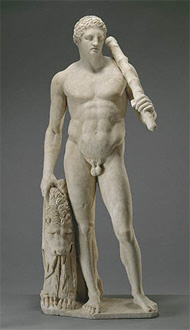Take your students into the world of Greek and Roman stories at the J. Paul Getty Museum at the Getty Villa. Six self-guide activities introduce students to these ancient tales about heroes, monsters, gods, goddesses, athletes, and aristocrats through writing and drawing activities. |
 |
 |
Students should be able to:
• recognize specific Greek and Roman mythological characters in works of art.
• make connections between a written story and an artist's visual depiction of the same story.
• compare how different artists represent the same subjects.
• identify ways that artists use body language, gesture, and facial expression to convey meaning. |
 |
 |
The activity pages included here are for use in the Villa galleries, and short classroom investigations are outlined for each activity to help you prepare for your visit to the Villa.
1. Prepare your students for their Villa visit and for using this unit by reviewing the images and links provided beneath each activity.
2. Review each of the the six activities. Each chaperoned group will do the activities in a different order. All students will do Postcard Memories last. On the day of your visit, chaperones and students will use the Itinerary sheet to note the order you give their group for the activities. You can omit activities if you need to. You may wish choose just 3–4 activities for your students to use while at the Villa, plus Postcard Memories.
3. Print out and make photocopies of all activity sheets for each student. The corresponding Villa galleries are noted on each sheet.
4. Use the follow-up activities noted at the bottom of each activity sheet to help students apply what they learned during their Villa visit.
5. Below is a description of each activity and its corresponding pre-visit and in-gallery investigations:
Attributes—Clues about Who's Who
In-Gallery Self-Guide: In this treasure hunt-like activity, students learn to recognize mythological characters in a story by identifying the unique clothes, weapons, or other objects—called attributes—that the characters wear or carry.
Pre-Visit: Show an image of the Lansdowne Herakles or the
Storage Jar with Herakles and Apollo Fighting over the Tripod to your students. What clues does Herakles hold that tell us who he is? These clues are called "attributes" and include a lion, or lion skin, and a club. Discuss with your students why Herakles is usually shown with these two objects. Use the story of the 12 labors of Hercules for reference. The Getty's publication for kids, Strong Stuff: Herakles and His Labors, describes all of Herakles' adventures with colorful illustrations.
Characters, Actions, and Settings
In-Gallery Self-Guide: Students read an excerpt from an ancient source and search for art objects in the galleries that depict the characters or the scene. They explore the relationship between ancient descriptions and artists' depictions.
Pre-Visit: Show the students two views of Medusa: Ladle with Perseus Chasing Gorgons and
Hand Mirror with the Head of Medusa, and read aloud the following excerpt adapted from Apollodorus Bibliotheca from the 1st–2nd century B.C.:
"Medusa alone was mortal; for that reason Perseus was sent to fetch her head. For the Gorgons had heads twined about with serpents, and great tusks like swine's, and brazen hands, and golden wings, by which they flew. And most disastrously, anyone who looked upon them was turned to stone."
Discuss the characters and actions portrayed on the cup with your students. What moment in the story of Perseus and Medusa has the artist depicted and why? When looking at the bronze mirror, have the students discuss why a Gorgon face would grace the backside of a mirror. How has the artist depicted the Gorgon in that work of art? How is it different from the scene on the cup?
Mythological Creatures
In-Gallery Self-Guide: Students read a description of a mythological monster and search for depictions of the monsters in a work of art. They then draw their own monster and write a story about it.
Pre-Visit: Show an image of the Wine Cup with Bellerophon Fighting the Chimaira to your students and have them identify the components of each creature depicted (i.e. wings, heads, horns, hooves, etc.). Discuss what the relationship between these two creatures might be, as well as their connection to the hero Bellerophon, based on the way the artist composed the scene.
Lasting Impressions
In-Gallery Self-Guide: Students investigate a portrait of a Roman woman and compare it to the depiction of Julia Titi.
Pre-Visit: Have the class look at the Head of Julia Titi. Have them identify the distinguishing features of the portrait and discuss why the artist may have included them. What does the hairstyle tell us about her? Is she old or young, sad or happy? What did the artist want us to know about her?
Body Language
In-Gallery Self-Guide: Students compare two depictions of ancient athletes and consider how the artists used body language to create similarities and differences in mood and expression.
Pre-Visit: Have your students compare the body language of these two discus throwers: Statuette of a Discus Thrower and Statuette of a Discus Thrower. What are the similiarities and differences in their stance, expression, and rendering? Why would the artists chose to depict discus throwers differently?
Postcard Memories
In-Gallery Self-Guide: Students write a postcard to a friend or their family about their visit to the Getty Villa and describe a person or story that they saw depicted in their favorite work of ancient art.
Pre-Visit: Show the Villa Orientation Film to your students to give them a sense of what they will see and do during their visit to the Villa. Find the film in the Visit Section of this Web site.
|
 |
 |
 |
| The Lansdowne Herakles, Roman, about A.D. 125 |
 |
|

